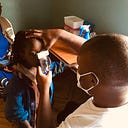OUI Inc. Developed Corneal Opacity Detection AI Using Slit-Lamp Microscope Images!!
OUI Inc., A Japanese startup who develops the Smart Eye Camera, a medical device that enables ophthalmic diagnosis using a smartphone, has developed an AI model that can detect corneal opacity, one of the causes of blindness in the world.
Mr. Kenji Yoshitsugu, Dr. Eisuke Shimizu, and their research group at OUI Inc. have successfully developed an AI algorithm to “detect corneal opacity” from anterior segment images captured with the Smart Eye Camera. The research results were published in the scientific journal Bioengineering on March 13, 2024 (Japan Standard Time).
Corneal opacity is a disease caused by infection, trauma, heredity, vitamin A deficiency, etc., which leads to vision loss and is one of the leading causes of blindness worldwide. Blindness due to corneal opacity occurs mainly in developing countries in particular, and corneal opacity caused by infection or vitamin deficiency during childhood can also lead to complications such as amblyopia. However, due to a lack of medical equipment and ophthalmologists, blindness caused by corneal opacity cannot be prevented as of 2024.
Recently, the use of artificial intelligence (AI) has been gaining popularity in the medical field as well. In the field of ophthalmology, AI is being actively developed around the world, especially for screening and diagnosis of retinal and optic nerve diseases (fundus diseases). However, as of March 2024, there has been no progress in the development of AI for anterior eye diseases such as corneal opacity. One of the reasons for this is that it is difficult to obtain a large amount of uniform slit-lamp microscope image data, which is necessary for machine learning for the development of diagnostic AI.
Against this backdrop, we have developed our own Smart Eye Camera (SEC; medical device registration numbers: 13B2X10198030101, 13B2X10198030201, 13B2X10198030301) to collect images of the anterior eye and develop AI for diagnosis of various anterior eye diseases. We are focusing on starting AI development.
In this study, we use SEC to acquire image data from slit-lamp microscopes, extract image frames from videos, annotate them by ophthalmologists (to create teacher data), extract corneas by semantic segmentation, image processing using applied histogram flattening (CLAHE), and convolution We attempted to develop an AI for diagnosing corneal opacity from anterior segment images by performing deep learning using a neural network (CNN) model.
In this study, ophthalmologists labeled (annotated) a total of 5,996 images collected using SEC as to whether or not they had corneal opacity, and classified them into 1,617 images with corneal opacity and 4,379 images without corneal opacity. As image preprocessing, we extracted corneal regions using semantic segmentation (Figure 1), adjusted image contrast using CLAHE (Figure 2), and performed machine learning using the EfficientNet-B4 CNN model.
As a result, sensitivity: 0.96 (95% confidence interval: 0.97–0.99), specificity: 0.96 (95% confidence interval: 0.97–0.99), accuracy: 0.96 (95% confidence interval: 0.97–0.99), AUC: 0. The performance was high: accuracy: 0.96 (95% confidence interval: 0.97–0.99), AUC: 0.98 (95% confidence interval: 0.97–0.99), and AUC: 0.98–0.99.
These results indicate that the algorithm has high diagnostic performance in the diagnosis of corneal opacity, a result that is expected to be fully practical. It was also considered academically significant that a high-performance algorithm was developed from approximately 6,000 images by applying image preprocessing such as semantic segmentation and CLAHE to the development of an image diagnosis AI, which conventionally would require the collection of a large number of images exceeding 10,000.
In the future, by validating this algorithm with external data sets, we will develop a model optimized for actual clinical use and promote its practical application as a programmed medical device (SaMD; Software as a Medical Device).
In addition to corneal opacity, we are developing diagnostic AI for various ophthalmic diseases, such as diagnostic AI for cataract and dry eye.
This research was supported by the Japan Agency for Medical Research and Development and other organizations.
